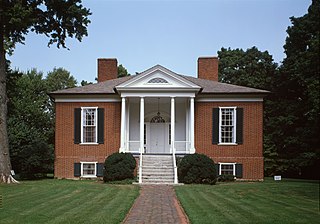
Farmington, an 18-acre (7.3 ha) historic site in Louisville, Kentucky, was once the center of a hemp plantation owned by John and Lucy Speed. The 14-room, Federal-style brick plantation house was possibly based on a design by Thomas Jefferson and has several Jeffersonian architectural features.

Crown Hill National Cemetery is a U.S. National Cemetery located in Indianapolis, Marion County, Indiana. It was established in 1866 on Section 10 at Crown Hill Cemetery, a privately owned cemetery on the city's northwest side. Administered by the United States Department of Veterans Affairs, the National Cemetery encompasses 1.4 acres (0.57 ha) and serves as a burial site for Union soldiers who fought in the American Civil War.

Richmond National Cemetery is a United States National Cemetery three miles (4.8 km) east of Richmond in Henrico County, Virginia. Administered by the United States Department of Veterans Affairs, it encompasses 9.7 acres (3.9 ha), and as of 2005 had 9,322 interments. It is closed to new interments. Richmond National Cemetery was listed on the National Register of Historic Places in 1995.
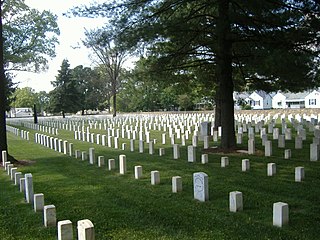
New Albany National Cemetery is a United States National Cemetery located in the city of New Albany, in Floyd County, Indiana. Administered by the United States Department of Veterans Affairs, it encompasses 5.5 acres (2.2 ha), and as of the end of 2005, had 6,881 interments. It is managed by Zachary Taylor National Cemetery.
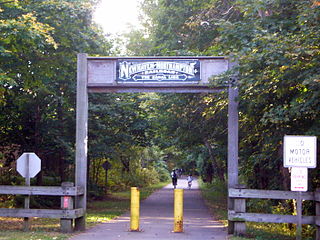
The Farmington Canal, also known as the New Haven and Northampton Canal, was a major private canal built in the early 19th century to provide water transportation from New Haven into the interior of Connecticut, Massachusetts and beyond. Its Massachusetts segment was known as the Hampshire and Hampden Canal. With the advent of railroads, it was quickly converted to a railroad in the mid-19th century and in recent years has been converted to a multi-use trail after being abandoned for years.

The Thomas Hart Benton Home and Studio State Historic Site is a state-owned property located at 3616 Belleview, Kansas City, Missouri, that preserves the house and studio of Missouri artist Thomas Hart Benton. The historic site was established in 1977 and is managed by the Missouri Department of Natural Resources. Tours are provided that show the furnished house and studio as Benton left it when he died on January 19, 1975. The site was listed on the National Register of Historic Places in 1980.

The Confederate Memorial State Historic Site is a state-owned property occupying 135 acres (55 ha) on the northern edge of Higginsville, Missouri. The site was established in 1952 to preserve what had been from 1891 to 1950 the Confederate Soldiers Home of Missouri.

Roaring River State Park is a public recreation area covering of 4,294 acres (1,738 ha) eight miles (13 km) south of Cassville in Barry County, Missouri. The state park offers trout fishing on the Roaring River, hiking on seven different trails, and the seasonally open Ozark Chinquapin Nature Center.
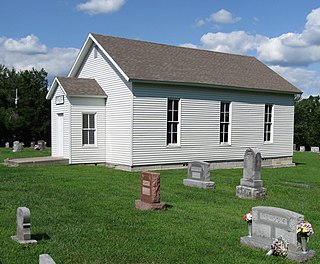
Bond's Chapel Methodist Episcopal Church, also known as Bond's Chapel, is a historic Methodist Episcopal church located near Hartsburg, Missouri. It was built in 1883-1884, and is a simple rectangular frame building, set on piers composed of creek rock and mortar. It measures 24 feet by 33 feet and has a front gable roof and vestibule.

Brookside Cemetery is a historic cemetery located along North Union Street in the city of Tecumseh in northern Lenawee County, Michigan. It was designated as a Michigan Historic Site and added to the National Register of Historic Places on August 13, 1986.

Presbyterian Orphanage of Missouri, also known as Farmington Children's Home and Presbyterian Children's Home, is a historic orphanage and national historic district located at 412 West Liberty Street in Farmington, St. Francois County, Missouri. The district encompasses five contributing large brick buildings built between 1939 and the early 1950s in the Georgian Revival style. They are the Administration Building and Dining Hall, built in 1939 and enlarged in the 1940s, two large dormitories built in the early 1950s, and a smaller "hospital" building known as Holmes Cottage built in 1940. The Presbyterian Children's Home vacated the campus in 1999. The campus is currently an apartment complex for senior citizens.

This is a list of the National Register of Historic Places listings in Mississippi County, Missouri.

Farmington Historic District is a national historic district located at Farmington, Davie County, North Carolina. The district encompasses 87 contributing buildings, 2 contributing sites, and 3 contributing objects in the unincorporated community of Farmington. It primarily includes residential, agricultural, commercial, religious, and educational buildings with notable examples of Greek Revival, Italianate, Queen Anne, American Craftsman, and Colonial Revival style architecture. Notable contributing resources include the Farmington Community Cemetery (1881), Wiseman-Kennen House (1873), Dr. Lester P. and Helen Bahnson Martin House, Williard Garage (1920s), Francis Marion Johnson Store, Charles F. and Jane A. Bahnson House, Jarvis-Horne Store, Brock Marker, Farmington School Auditorium, Cafeteria, and Home Economics Classroom, Farmington School Agricultural Building (1936), (former) Farmington Baptist Church (1882), Farmington Methodist Church, and Farmington Post Office/Barber Shop.
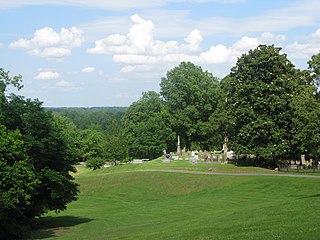
The Helena Confederate Cemetery is located in the southwest corner of the Maple Hill Cemetery on Holly Street in Helena, Arkansas. It is a small section of the larger cemetery, under one acre in size, and is marked by two significant memorials: the Confederate Memorial and the memorial to Confederate Army General Patrick Cleburne, whose burial here is the only known place associated with his life. The Cleburne memorial is a marble shaft 15 feet (4.6 m) in height, topped by an urn with flames coming from its top. The Confederate Memorial is a marble depiction of a soldier, mounted on a 30-foot (9.1 m) granite shaft, surrounded by pyramids of cannonballs and inverted cannons. The cemetery has more than 100 marked graves, 15 of which are unidentified Confederate dead, and 23 are of those killed in the 1863 Battle of Helena.

Wildwood Cemetery and Mary Lyon Fisher Memorial Chapel is a historic cemetery and chapel located at Lyons Falls in Lewis County, New York. The cemetery was established in 1906, and the chapel constructed in 1921. It remains an active burial ground containing 736 marked burials. The memorial chapel is a two-story, masonry building in the Late Gothic Revival style. It consists of a rectangular main section, measuring 19 feet by 24 feet, with a rear chancel addition measuring 9 feet by 15 feet. Also in the cemetery is a contributing plaque to Caleb Lyon Sr.

Aker Cemetery is a historic cemetery located near Smithville, Clay County, Missouri. The Aker Cemetery is the only remaining evidence of the initial settlers in the area. It was established about 1835, and contains 10 marked gravesites dated from 1835 to 1882, and a total of 25 graves.

Mt. Memorial Cemetery, also known as The Old Gravevard, is a historic cemetery located on the campus of William Jewell College at Liberty, Clay County, Missouri. It was established about 1828, and contains 554 documented burials. The cemetery is rectangular in plan and measures approximately 140 feet by 435 feet.

Berry Cemetery, also known as Holy Resurrection Cemetery, is a historic cemetery located near Ash Grove, Greene County, Missouri. It was established about 1875, and is a small, rural African-American cemetery. It contains 48 marked graves dating from 1875 to 1948. It may also contain Native American burials in three burial mounds.

Henry H. Hohenschild, also known as H.H. Hohenschild, was an architect based in Rolla, Missouri, USA. He born at St. Louis, and educated in the city's public schools. He moved to Rolla in 1881, where he established an architectural practice designing public and residential buildings. He was elected to the Missouri Senate in 1896. In 1899 was appointed State Architect by Governor Lon V. Stephens which involved the architect in designing several state buildings including some at the state penitentiary. In addition to 10 county courthouses, he designed several buildings for the School of Mines, the State Mental Institution in Farmington (1901), the Tuberculosis Sanitarium in Mount Vernon, Missouri (1905), and the temporary state capitol building in Jefferson City in 1912. He died on February 3, 1928 in St. Louis from a heart condition.

























